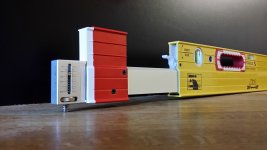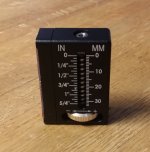Good points. I too make extensive use of lasers. I was an earlier adapter of PLS tools before Stabila and the others ever entered the laser market. For a myriad tasks, lasers are pure magic. And clearly there are many situations where other methods are good substitutes and/or eliminate the need for the How Far Out gauge, especially in new construction. These are facts we'd all agree upon.
But just as the soldier on the ground will always have use for an accurate side-arm, even though modern weaponry includes nukes and smart bombs, there will always be situations where we want to get the most from our hand levels. It's a matter of range, required accuracy, convenience, and circumstance.
The intended purpose of the How Far Out gauge is definitely not to supplant all other layout tools or methods. It's simply designed as a specialty installation and survey tool to enhance the use of your hand levels in any situation where you would otherwise have to space your level by hand and then try to simultaneously read the bubble while you eyeball the gap in order to know how far out things are. Depending on the type of work you do, this functionality may or may not justify a place in your toolbox for the How Far Out gauge.
Its primary reason for being is its ability to take any guesswork out of surveying the size and shape of existing small-scale finished openings, especially where direct scribing is not convenient or possible --- for new doors being fitted to old frames, wall-to-wall mirrors, shower enclosure glass, enclosed millwork installations, and the like. But if you start using one, you'll find that other handy uses come up as well. In particular, there are times when the simple ability to steadily and precisely position the level is useful independent of the use of its gauge.


